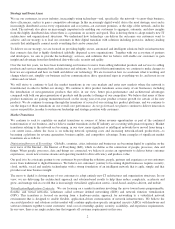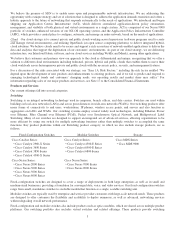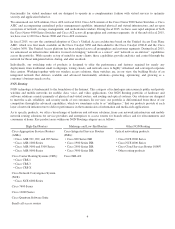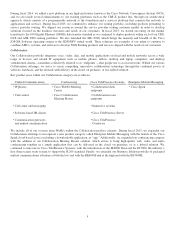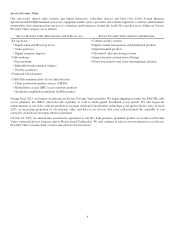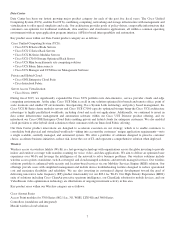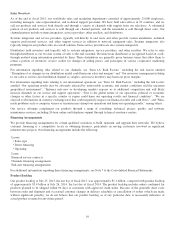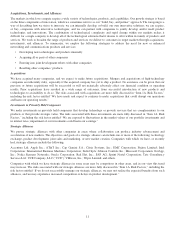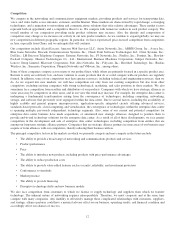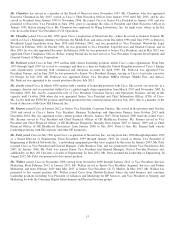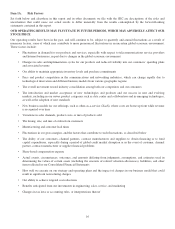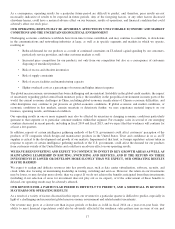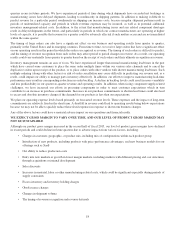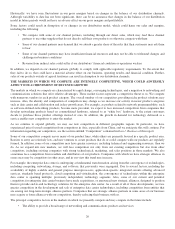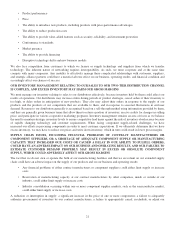Cisco 2015 Annual Report Download - page 19
Download and view the complete annual report
Please find page 19 of the 2015 Cisco annual report below. You can navigate through the pages in the report by either clicking on the pages listed below, or by using the keyword search tool below to find specific information within the annual report.Acquisitions, Investments, and Alliances
The markets in which we compete require a wide variety of technologies, products, and capabilities. Our growth strategy is based
on the three components of innovation, which we sometimes refer to as our “build, buy, and partner” approach. The foregoing is a
way of describing how we strive to innovate: we can internally develop, or build, our own innovative solutions; we can acquire,
or buy, companies with innovative technologies; and we can partner with companies to jointly develop and/or resell product
technologies and innovations. The combination of technological complexity and rapid change within our markets makes it
difficult for a single company to develop all of the technological solutions that it desires to offer within its family of products and
services. We work to broaden the range of products and services we deliver to customers in target markets through acquisitions,
investments, and alliances. To summarize, we employ the following strategies to address the need for new or enhanced
networking and communications products and services:
• Developing new technologies and products internally
• Acquiring all or parts of other companies
• Entering into joint development efforts with other companies
• Reselling other companies’ products
Acquisitions
We have acquired many companies, and we expect to make future acquisitions. Mergers and acquisitions of high-technology
companies are inherently risky, especially if the acquired company has yet to ship a product. No assurance can be given that our
previous or future acquisitions will be successful or will not materially adversely affect our financial condition or operating
results. Prior acquisitions have resulted in a wide range of outcomes, from successful introduction of new products and
technologies to an inability to do so. The risks associated with acquisitions are more fully discussed in “Item 1A. Risk Factors,”
including the risk factor entitled “We have made and expect to continue to make acquisitions that could disrupt our operations
and harm our operating results.”
Investments in Privately Held Companies
We make investments in privately held companies that develop technology or provide services that are complementary to our
products or that provide strategic value. The risks associated with these investments are more fully discussed in “Item 1A. Risk
Factors,” including the risk factor entitled “We are exposed to fluctuations in the market values of our portfolio investments and
in interest rates; impairment of our investments could harm our earnings.”
Strategic Alliances
We pursue strategic alliances with other companies in areas where collaboration can produce industry advancement and
acceleration of new markets. The objectives and goals of a strategic alliance can include one or more of the following: technology
exchange, product development, joint sales and marketing, or new market creation. Companies with which we have, or recently
had, strategic alliances include the following:
Accenture Ltd; Apple Inc.; AT&T Inc.; Cap Gemini S.A.; Citrix Systems, Inc.; EMC Corporation; Fujitsu Limited; Intel
Corporation; International Business Machines Corporation; Italtel SpA; Johnson Controls Inc.; Microsoft Corporation; NetApp,
Inc.; Nokia Siemens Networks; Oracle Corporation; Red Hat, Inc.; SAP AG; Sprint Nextel Corporation; Tata Consultancy
Services Ltd.; VCE Company, LLC (“VCE”); VMware, Inc.; Wipro Limited; and others.
Companies with which we have strategic alliances in some areas may be competitors in other areas, and in our view this trend
may increase. The risks associated with our strategic alliances are more fully discussed in “Item 1A. Risk Factors,” including the
risk factor entitled “If we do not successfully manage our strategic alliances, we may not realize the expected benefits from such
alliances, and we may experience increased competition or delays in product development.”
11



